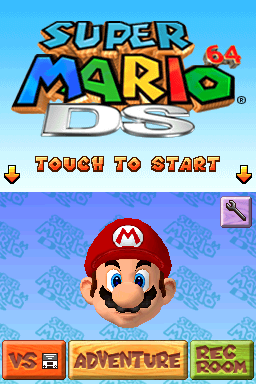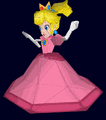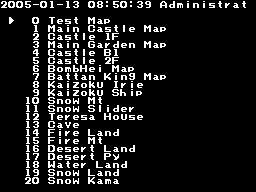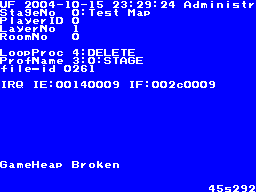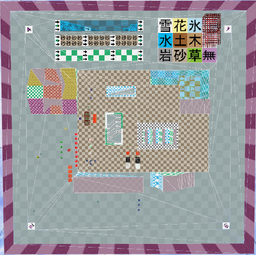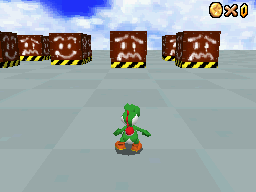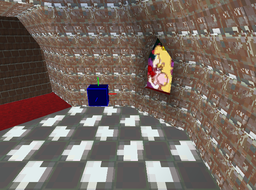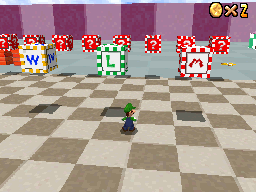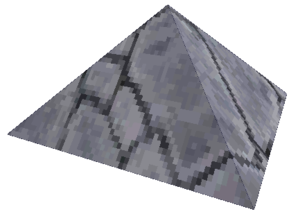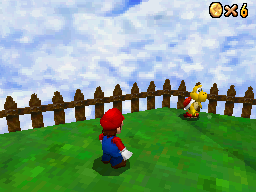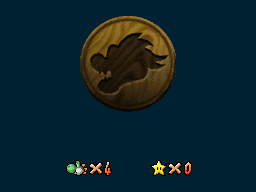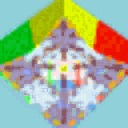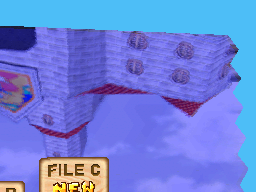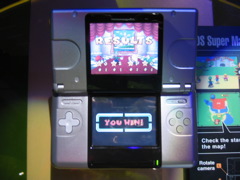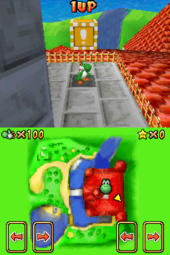Super Mario 64 DS
| Super Mario 64 DS |
|---|
|
Also known as: Shényóu Mario DS / 神游马力欧 DS (CN)
|
Super Mario 64 DS is a remake of the N64 original, adding minigames, new playable characters, new areas, improved graphics, and 30 more Stars to collect.
To do:
|
Contents
Sub-Pages
| Prerelease Info |
| Notes |
| Bugs |
| Unused Text Leftover or originally mentioned. |
| Oddities The black box lives! |
Unused Animations
| To do: Add IDs, and confirm which ones are used for comparison |
Non-specific walking, running, and jumping animations can be found for Peach alongside the rest of her animations used in the game's intro and ending scenes, located in the game's data/enemy/peach folder. Notably, the enemy folder is where the graphics and animations for all of the game's non-playable characters are located.
Peach's intro and ending cutscene animations are prefixed with op and ed respectively:
peach_ed_enter_wait.bca
peach_ed_kiss.bca
peach_ed_landing.bca
peach_ed_look_about.bca
peach_ed_lookup.bca
peach_ed_lookup_to_wait.bca
peach_ed_notice_mario.bca
peach_ed_notice_yoshi.bca
peach_ed_step_up.bca
peach_ed_turn.bca
peach_ed_wait.bca
peach_ed_walk.bca
peach_ed_wave.bca
peach_op_wait.bca
Whereas these animations don't feature any prefixes indicating their use in intro and outro cutscenes:
peach_jump_end.bca
peach_jump_loop.bca
peach_jump.bca
peach_run.bca
peach_wait.bca
peach_walk.bca
Map Select
The game contains a map select screen that can be reenabled using the Action Replay codes below. It appears upon loading a save file and allows access to every map in the game, including test levels. The ROM's build date is displayed at the top of the screen.
To use the map select, enter Action Replay code 2202???? 00000002, where "????" is the value that matches your version.
| Japan | US | Europe | US Kiosk Demo |
|---|---|---|---|
| A07C | 9E00 | AED8 | A098 |
| Japan Revision 1 | US Revision 1 | Korea | China |
| A0B4 | A0B8 | 9EB8 | C208 |
More so, selecting a map that lacks a star select screen from the map select menu instead brings a plain screen with a wooden Bowser emblem. In addition, a Bowser jingle (with laugh included) will play instead of the standard level jingle when loading the Bowser boss maps.
Build Date
Within the ROM there is a text file called BUILDTIME that contains the following build dates:
| US | Japan | US Revision 1 | Japan Revision 1 |
|---|---|---|---|
| 2004-10-15 23:29:24 Administrator | 2004-10-25 18:50:33 Administrator | 2004-11-05 21:13:01 Administrator | 2004-11-09 12:31:12 Administrator |
| US Kiosk Demo | Europe | China | Korea |
| 2004-11-11 11:16:17 Administrator | 2005-01-13 08:50:39 Administrator | 2007-05-16 11:41:10 yosimoto | 2007-05-18 22:30:30 Administrator |
Crash Debugger
This game has a crash debugger triggered similarly to the one in Ocarina of Time. This one is a bit less technical and more informative, but a lot less in-depth.
To access the crash dump screen, crash the game (such as ejecting the game card). After doing so:
- Hold L + R + A + Left, then release.
- Hold Down + B, then release.
- Hold Start + Select.
This screen also exists in Animal Crossing: Wild World and New Super Mario Bros. It was used by the developers to debug crashes and other errors in the game since it helps pinpoint exactly where an issue occurred in the code.
Here's an explanation of some of the info on it:
- The BUILDTIME text file is printed on the top of the screen.
- StageNo - Internal name of the stage.
- PlayerID - The character that was being used at the time.
- LayerNo - Unknown.
- RoomNo - Unknown.
- LoopProc - Which part of the main loop was running at the time of the crash; corresponds to a specific virtual function on the problem actor.
- ProfName - Identifies which actor type caused the problem. The first number is the type ID (in the above screenshot it is 3, which corresponds to STAGE). The second number is unknown.
- file-id - Unknown, may be the last file ID that was read from the ROM's file system.
Unused Areas
Test Maps
There are two test levels in the game. Either input the Action Replay codes listed on the Notes page, then hold Select when loading a used save file, or use the map select. The levels don't have proper star select screens, so they just display text from other parts of the game. The names for the unused maps come from the crash debugger/map select and model/directory names, respectively.
Test Map (test_map)
| To do: Expand on the different functions of the objects/terrain in the levels, including info on which objects appear during which missions. |
This is where the real meat is. Lots of stuff used for terrain and object testing, as well as general level testing stuff.
The checkerboard textures from Super Mario Sunshine's debug room make their third appearance here. They must really get around.
There are some tiles in the top-right corner of the map with Japanese characters. Each one exhibits the corresponding ground type's behavior when stepped upon:
- Top Row - 雪 (Snow), 花 (Flower), 氷 (Ice)
- Middle Row - 水 (Water), 土 (Soil), 木 (Wood)
- Bottom Row - 岩 (Rock), 砂 (Sand), 草 (Grass), 無 (Nothing)
On the left, the three tracks with arrow marks demonstrate conveyors: flowing water, flowing quicksand (as in Pyramid Puzzle), and a more ordinary type.
Between these and the three pushable boxes below, two invisible poles exist (shown in blue in the above rendering).
Of the four brick walls in the gray checkerboard area roughly in the middle, two of them are only solid at the grey short faces.
The inverted staircase at the bottom of the level can be hung to, and the bottom-most step can awkwardly be walked into. Just above is a row of red item blocks, where the closest three contain a Flower but the 1st and 3rd have a bomb/wing respectively if opened by Mario, the next one a Mushroom, then afterwards a Shell, and finally two non-respawning ones with respectively an 1-Up and some coins; notably, the Mushroom one is otherwise unused (as are the nearby cap blocks) while the other latter effects are used in orange "!" item blocks instead.
The numbered corners are demonstrations of paired warps (1-2 and 3-4).
Onimasu Test Map (test_map_b)
This level mostly consists of a flat checkerboard plain with a bunch of Tox Boxes trundling around. This map was used for testing them as the name "Onimasu" (オニマス) is the Japanese name for Tox Box.
There is also an icon for the spiked balls from the Bowser battle in the top left corner of the map.
Original Peach's Room
In the original game, the room containing The Princess' Secret Slide is a small hexagonal room with a sign and three stained-glass windows of Peach. The DS remake replaced this with a much larger room in a separate map with the sign, two stained-glass windows - with the one on the right warping to the slide, doors that allow you to swap characters, and a door going to Peach's Rec Room.
Despite this, the original room is still a part of the castle model, complete with the sign and Secret Slide warp, though most of the textures are incorrect and it doesn't have any collision. The sign has the same settings as the final room.
By removing the warp behind the door in the foyer that goes to the map containing the new room, setting the door so it goes to area 6 (the area the original room is in), and adding collision data, the player can enter it.
In the early room, the setting of the exit that defines the entrance the player returns to after losing a life or getting a star is set to entrance 0x00 - standing on the center of the main castle floor, which is also used when the player exits a level via the pause menu. In the final room, the exit is set to entrance 0x0 - falling down to the center of the main castle floor, which is also used for when you lose a life or get a star in the "? Switch" level. The warp is also smaller in the early room, to fit the smaller window.
Unused Actors
| To do: There are four unused Tick Tock Clock mechanical objects. Document them and check if they exist in the original game. (source: Fiachra) |
Cap Blocks (0x0021 to 0x0023)
| Internal Name | Object | Actor | Files |
|---|---|---|---|
|
|
|
/data/normal_obj/obj_hatena_box/
|
The game contains three M/L/W blocks that give the corresponding character's cap when hit. These objects work perfectly but are unused in the final game. However, they can be found in the Test Map. They won't release anything unless the character is already unlocked, or the cap object exists in the level via object 254.
Using the following Action Replay code for the appropriate version will cause these blocks to spawn. The USA code replaces trees with them while the European code spawns them near the player.
| Block | USA Code | Europe Code |
|---|---|---|
| M Block | 1210443A 00000017 | 021130EC 00000021 |
| L Block | 1210443A 00000018 | 021130EC 00000022 |
| W Block | 1210443A 00000019 | 021130EC 00000022 |
Rock Triangle (0x00B6)
| To do: This piece of rock is used under the falling pillars in Jolly Rodger Bay. Can it be seen? |
| Internal Name | Object | Actor | Files |
|---|---|---|---|
|
|
|
/data/special_obj/ki_hasira/
|
A rock triangle only solid on top. Yay.
Multiplayer Stairs and Barrier (0x0128 & 0x0129)
| Internal Name | Object | Actor | Files |
|---|---|---|---|
|
|
|
/data/special_obj/
|
The multiplayer Peach's Castle features direct reproductions of the stair and barrier objects as part of the level model, so the separate objects are unused.
There is an Action Replay code for the USA version here (will appear near you): Multiplayer Stairs: 021130ec 00000128 Multiplayer Barrier: 021130ec 00000129
Red Koopa
| Internal Name | Object | Actor | Files |
|---|---|---|---|
|
NOKONOKO |
21 |
203 |
/data/enemy/nokonoko/
(and the standard Koopa animation files) |
This Koopa shows different behavior than the standard green version. It runs into the player rather than fleeing from them, though it doesn't hurt the player. When knocked out of its shell, it will chase after it. When defeated while shell-less, it gives a blue coin, just like green Koopas.
The shell obtained from knocking a Red Koopa cannot be ridden or picked up. The player can kick it to launch it in one direction; it then continues following a straight line, knocking out enemies in its path, until it crashes into a wall and disappears in a puff of smoke. If Yoshi eats a red shell, he can spit fire, as he could in Super Mario World.
Red Koopa Troopas can be added to a level by changing a Koopa's Parameter1 to 0x0001. They can also be seen with the following Action Replay codes.
| Version | Code |
|---|---|
| USA Revision 1 (replaces trees with Red Koopas) |
1210443A 000000CB |
| Europe (will appear near you) |
021130EC 00000215 |
| Europe (makes a red shell appear near you) |
021130EC 00000254 |
Unused Actor Parameters
- Tox Boxes are able to follow regular paths, and that's what they do in the second test map (Onimasu Test Map). However, in Shifting Sand Land, the only used level where they appear, this ability isn't used; they follow hardcoded paths instead.
- If the Power Flower object has Parameter1 set to 1, it acts like the Wing. At some point in development, the Wing Cap may have been obtained from a Power Flower instead of causing Mario to float.
Unused Actor Behaviors
- Some enemies have a behavior for touching the character when they are huge, even if you cannot become huge in that level. Sometimes it is just how they react to metal characters, but sometimes they have unique behavior for the powerup (mostly just being destroyed).
- Princess Peach, as she appears in the ending, has a behavior for being talked to; you can do this by placing Peach in a map with a level editor and going up to her and pressing A or B. When talked to she goes into her default pose of standing completely still and upright, which looks quite awkward, and says the same lines Bowser says at the start of the final boss battle. This does not necessarily mean that you could have talked to Peach at some point in development; the behavior could just have been put there for some technical reason.
- The Ice Block, Pushable Block, CCM Ski Lift, and CCM Ice Sheet can be smashed by players in giant form. The CCM Ski Lift breaks up into Brick Block shards, like the Rolling Log object (and Brick Block) does, but the Ice Block and Pushable Block have their own unique shards. The CCM Ice Sheet has to be ground-pounded and smashes the same way as when Wario ground pounds it, which is the used scenario.
Unused Entrances
| To do: rewrite this, adding images and listing which stages do/don't have the unused entrances |
Most levels have four entrances grouped around their starting point, out of which only one entrance is used for single-player levels, leaving the other three unused. The exceptions are the character painting levels and the Play Room, which suggests that they were created late in development.
Early footage saw multiple players in Bob-omb Battlefield.
The presence of the unused entrances indicates that the full 4-player mode was scrapped after most of the levels were already made, which is actually not that early in the game's development cycle. Since Super Mario 64 DS was one of the console's launch titles, it is quite probable that the cooperative mode was scrapped due to lack of time to finish it. Or simply due to technical constraints; note that Super Mario 64 DS is one of the rare games that includes Download Play but not multi-card play.
In the final game, it was replaced by a competitive game limited to scaled-down versions of four small courses.
It's worth noting that a full-game multiplayer mode was, according to some interviews, planned for the original Nintendo 64 game (and its canceled 64DD expansion), using the split-screen variation. It appears that they originally intended to revive the concept in this remake.
Unused Graphics
Goomba Low-Model
An unused low-polygon model for a Goomba. The game originally switched out the normal model with this one at a certain distance from the camera, but the low draw distance for objects eventually rendered this useless. This functionality was still intact in the E3 demo, which can be observed at this timestamp, before the Goombas activate. Although coins still do use a low-model when viewed from a distance, this may be because there are often many on-screen at once.
Unused Star Select Screen
An unused, rather simple Bowser-themed variant for the star select screen. Used in the unused map select.
Battle Fort Painting
Its filename (for_vs_cross.bmd) implies that it was made for the Battle Fort level. It goes unused since the only entrances to the Battle Fort are a hole in the Courtyard and through VS Mode (which uses a generic sky painting). The painting object can be set to display this graphic.
It appears to depict an early design of the course, most notably the sides are multicolored and there are no squares on each edge.
5 Star Door
Star graphics for a door that would require five Stars to unlock... except the door object has no such variation. Interestingly, source code for the IQue version of the original game mentions a 5 Star door existing, making this a possible remnant.
Powerup Item
| File | Texture inside nsbmd |
|---|---|
/data/normal_obj/
|
|
The name for the Power Flower actor is obj_powerup_item, so it is likely that this was a placeholder graphic for the Power Flower.
Cyan Rabbit
The model file for the catchable rabbits in the game, found in data/enemy/mip/mip.bmd, contains a set of palettes that the model's texture uses for each of rabbits' colors, each given an ID for use by the game: 0 for Yoshi's yellow rabbits, 1 for Mario's pink rabbits, 2 for Luigi's green rabbits, and 3 for Wario's orange rabbits, with the white rabbits that appear after collecting 40 stars having an ID of 5. An additional palette and palette ID can be found between the orange and white rabbits, sporting a cyan color and having an ID of 4.
Coincentration Graphics
The sprite set from the minigame Coincentration contains some Mario and Luigi sprites from Super Mario Advance 4 which obviously aren't used in the final game. There's also an unused "defeated" Wario frame, which presumably would have been used before he falls on his back.
Early Wanted! Graphics
| Early | Final |
|---|---|
The files where the character's icons that appear in the Wanted! minigame include unused early designs for all four characters. The file with the tiles is found in root/MG/d_2d_mg_luigi_ncg.bin. The palette is found in root/MG/d_2d_mg_luigi_ncl.bin, where Palette 0 to 3 are used for the Early Yoshi, Mario, Luigi and Wario tiles respectively while palette 4 to 7 are used for the final Mario, Luigi, Wario and Yoshi tiles respectively. These two files also appear in New Super Mario Bros.
Mario and Luigi's head sprites are reminiscent of the unused Peace sign sprites in Super Mario Advance 4.
Hidden Graphics
| To do: Is this an oddity, or do they need to be this shape to achieve the shimmering effect? |
The left and right edges of the shape used for the shimmering water of the file select screen are spiky, but the edges are always offscreen so they can't be seen.
Naming Oddities
VS Painting Room
The model data for the room where the Yoshis jump into a painting in Vs. mode is named e3_start_map_r00.bmd. E3 likely refers to the event of the same name; presumably, the room was originally created for the demo version shown at E3, and then kept around and reused in the final version.
8-Star Door
The only Star door in the DS game which does not also exist in the original N64 version is the 8-Star one that leads to the Mario painting. Its graphics file is obj_door0_star10, indicating that this door went through some adjustments during development.
Coincentration
The "Coincentration" minigame's internal name is "wrecking_crew", a reference to the NES game.
Regional Differences
| International | Japan | Korea | China |
|---|---|---|---|
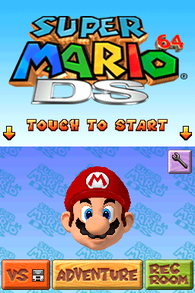
|
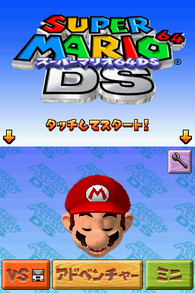
|
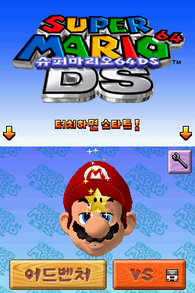
|
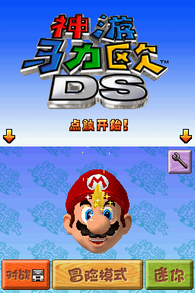
|
The Japanese logo features metal around the text and a more emphasized "DS" with a black outline around the letters. The Korean logo has slightly darker colors. The logo used in international versions is closer to the original design of the Super Mario 64 logo, with wood around the letters and gold around the "64". The "DS" is also less emphasized. Strangely, the word "Super" is all cyan rather than multicolored. The background gradient was also changed to match this cyan, whereas the Japanese version uses a deeper blue that matches the bottom screen colors. The Chinese version breaks tradition by rendering the majority of the title in Chinese, rather than using a subtitle. The Korean version lacks a Rec Room, as seen in the image above. Strangely enough, while the Korean logo is based on the Japanese logo, the background on the bottom screen is the same as the international version.
European Text Changes
For unknown reasons, the apostrophe character used in a few - but not most - of the English text strings in the European version was altered. In fact, the alterations were very inconsistent, as seen with the different apostrophes that were changed in the Big Bob-omb's introductions to Luigi and Wario, despite his first line being otherwise exactly the same. An extraneous space in one of Toad's lines was also removed, but none of the other extraneous spaces anywhere else in the game were!
| American | European |
|---|---|
I'm the Big Bob-omb, baron of all blasting matter, king of ka-booms worldwide! You've got some nerve making it this far. |
I'm the Big Bob-omb, baron of all blasting matter, king of ka-booms worldwide! You’ve got some nerve making it this far. |
I'm the Big Bob-omb, baron of all blasting matter, king of ka-booms worldwide! What's this? You're not royalty... |
I’m the Big Bob-omb, baron of all blasting matter, king of ka-booms worldwide! What's this? You're not royalty... |
It's been a while since I had a race like this. |
It’s been a while since I had a race like this. |
I think if you were a bit more shrewd and assertive, you could definitely move into a leading role! |
I think if you were a bit more shrewd and assertive, you could definitely move into a leading role! |
If you lose your cap, you'll find it in the course where you lost it. |
If you lose your cap, you’ll find it in the course where you lost it. |
Why don't you look for him on the Touch Screen map, Yoshi? |
Why don’t you look for him on the Touch Screen map, Yoshi? |
More logically, the localization, product testing and special thanks credits were altered to match the different regions:
| American | European |
|---|---|
NORTH AMERICAN LOCALIZATION NATE BIHLDORFF THOMAS CONNERY ANN LIN REIKO NINOMIYA LESLIE SWAN BILL TRINEN |
EUROPEAN LOCALIZATION PRODUCT LOCALIZATION PRODUCT LOCALIZATION TEAM COORDINATION NORIKO NETLEY ENGLISH TEXT THOMAS CONNERY ANN LIN |
| [N/A. The European version added an extra line here.] | TRANSLATION GERMAN MARTINA DEIMEL FRENCH THOMAS MIRIEL SPANISH JESÚS ÁNGEL RODRÍGUEZ GAGO ITALIAN ROBY BONOMO VALIDATION AND TESTING VALIDATION AND TESTING TEAM |
NOA PRODUCT TESTING YOSHINOBU MANTANI KYLE HUDSON ERIC BUSH SEAN EGAN RICH RICHARDSON TOM HERTZOG PATRICK TAYLOR MIKA KUROSAWA TERESA LILLYGREN |
DEBUG YUKI TANIKAWA NAOKI TAKAMI SUPER MARIO CLUB PRODUCT MANAGEMENT |
SPECIAL THANKS SEIKI ISHIHARA YUTAKA ARATA NORIHISA ASHIDA |
SPECIAL THANKS SEIKI ISHIHARA YUTAKA ARATA NORIHISA ASHIDA ALESSIO DANIELI HITOMI NAITOH |
Strangely again, none of the European text changes from the original game made their way to the European version of the remake where applicable, except for Wiggler's "I give" being changed to "I give up", which was applied to the American version as well.
Korean Version
To do:
|
- In Korea, there are very strict anti-gambling laws that assign any game with some form of interactive gambling content an "Adults Only" rating. To avoid this, the Rec Room menu and all of its associated mini-games were removed in the Korean version of Super Mario 64 DS. This also means that the bunnies that unlock mini-games and the Toad inside the Rec Room are missing. However, the shining bunnies that unlock the white door in the castle still appear.
- The Korean version lacks a backlight setting, as the only Nintendo DS model that would benefit from it was not released there.
- A unique Exclamation Point Block object appears on top of the castle, awarding unlimited extra lives when hit from below and acting like a normal solid object when hit from above or from the side. The Question Mark Block on the castle was moved to make room for it.
- A message is displayed on the boot screen if save memory is not detected.
Revisional Differences
To do:
|
US Revision 1
The following bugs/mistakes were fixed in this version:
- There are various bugs related to Yoshi's eating ability. Generally, if Yoshi or an object changes state while he's eating (e.g. a Power Flower disappears, or Yoshi takes damage), the game can glitch in various ways or freeze entirely.
- In Tall Tall Mountain, when Yoshi licks and eats a character transformation hat while Ukiki is jumping in the air, the game will freeze just before Yoshi finishes his transformation process.
- If the player collects or eats a transformation hat and their animation state changes (e.g. by collecting a Power Flower or grabbing hold of a ledge), then the transformation hat will remain stuck to the character's feet until another hat is collected or the player leaves the course.
- In Shifting Sand Land, if the player is wearing a transformation hat and lets Klepto bump into them while they are standing still and holding an item, the game will freeze.
- In Bob-omb Battlefield and Tiny-Huge Island, the Koopa Troopa and small Koopa Troopa (respectively) lack the ability to climb some steep surfaces, and will just walk in place.
- In Whomp's Fortress, if you grab the Super Mushroom, warp to the top of the fortress, make your way to the wooden plank and run up to the side of it, you'll get a constant stream of extra lives.
- In Dire Dire Docks, when the submarine is present, you can jump under one of the back fins and immediately ground pound to be pushed through the water surface, allowing you to walk underwater.
Europe
The European version inadvertently presents some new bugs.
- In Star 5 of Snowman's Land, "Snowman's Silver Stars", entering and exiting the igloo after collecting all five Silver Stars will cause them to respawn. Collecting one will cause everything but Mario to freeze (or cause the game to freeze if you're riding on a Koopa shell).
- A glitch was introduced that allows you to carry Stars by jumping on a Goomba and eating a Star as Yoshi. They have basic physics when spat out, sliding along the ground.
- One form of the Yoshi tongue glitch is possible in Jolly Roger Bay by licking up a cap and getting squashed by a pillar before the cap goes into Yoshi's mouth.
Korea
The Korean version fixes the game freeze part of the Silver Star glitch, but the rest of the glitch still occurs.
- Pages missing developer references
- Games developed by Nintendo EAD
- Pages missing publisher references
- Games published by Nintendo
- Games published by iQue
- Nintendo DS games
- Pages missing date references
- Games released in 2004
- Games released in December
- Games released on December 2
- Games released in November
- Games released on November 21
- Games with unused animations
- Games with unused areas
- Games with hidden development-related text
- Games with unused enemies
- Games with unused objects
- Games with unused models
- Games with unused items
- Games with unused text
- Games with debugging functions
- Games with hidden level selects
- Games with regional differences
- Games with revisional differences
- Pages with a Data Crystal link
- To do
- Mario series
Cleanup > Pages missing date references
Cleanup > Pages missing developer references
Cleanup > Pages missing publisher references
Cleanup > To do
Games > Games by content > Games with debugging functions
Games > Games by content > Games with hidden development-related text
Games > Games by content > Games with hidden level selects
Games > Games by content > Games with regional differences
Games > Games by content > Games with revisional differences
Games > Games by content > Games with unused animations
Games > Games by content > Games with unused areas
Games > Games by content > Games with unused enemies
Games > Games by content > Games with unused items
Games > Games by content > Games with unused models
Games > Games by content > Games with unused objects
Games > Games by content > Games with unused text
Games > Games by content > Pages with a Data Crystal link
Games > Games by developer > Games developed by Nintendo > Games developed by Nintendo EPD > Games developed by Nintendo EAD
Games > Games by platform > Nintendo DS games
Games > Games by publisher > Games published by Nintendo
Games > Games by publisher > Games published by Nintendo > Games published by iQue
Games > Games by release date > Games released in 2004
Games > Games by release date > Games released in December
Games > Games by release date > Games released in December > Games released on December 2
Games > Games by release date > Games released in November
Games > Games by release date > Games released in November > Games released on November 21
Games > Games by series > Mario series
